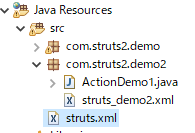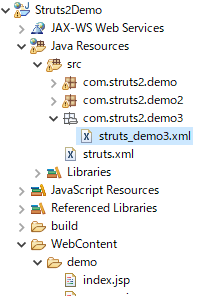一、Struts2配置
通过Struts2入门了解到Struts2需要使用过滤器,那么就必须配置过滤器的配置(web.xml),既然使用的是Struts2,当然也少不了Struts2本身的配置了(struts.xml)
关于配置过滤器(web.xml)可参照https://www.cnblogs.com/WarBlog/p/13434453.html
二、struts.xml配置
①、package:包与Java中的包的概念不一致。它为了更好管理action的配置。
<!--name随意,extends自struts-default --> <package name="strutsTest" extends="struts-default"> <!-- action节点,name为地址栏输入时用的名字,class为class文件的位置 --> <action name="hello" class="com.struts2.demo.HelloAction"> <!-- name 为刚才编写的action类中,execute返回的值 index.jsp的意思是返回到index.jsp页面 --> <result name="success">success.jsp</result> </action> </package>
-
- name :包的名称,只有在一个项目中不重名即可。
- extends:继承哪个包,通常值为struts-default。
- namespace:名称空间,与<action>标签中的name属性共同决定访问路径。
- 名称空间有三种写法:
- 带名称的名称空间:namespace=”/aaa”
- 跟名称空间:namespance=”/”
- 默认名称空间 :namespace=””
- 名称空间有三种写法:
- abstract :抽象的,用于其他包的继承。
②、action:配置相应的Action类
-
- name :与namespace共同决定访问路径
- class :Action类的全路径
- method :执行Action中的哪个方法的方法名,默认值execute
- converter :用于设置类型转换器
三、常量配置
①、常量默认值配置在default.properties
struts.i18n.encoding=UTF-8 ----Struts2中所有的post请求的中文乱码不用处理。
struts.action.extension=action,, ----Struts2请求的默认的扩展名。默认扩展名是.action或者什么都不写
②、修改常量值,三个地方
2.1、struts.xml中进行修改
<constant name="struts.action.extension" value="action" />
2.2、struts.properties:在src下新建一个struts.properties文件,用于常量修改
struts.action.extension=action
2.3、web.xml中修改常量,通过过滤器中的初始化参数
<filter> <filter-name>struts2</filter-name> <filter-class>org.apache.struts2.dispatcher.filter.StrutsPrepareAndExecuteFilter</filter-class> <init-param> <param-name>struts.action.extension</param-name> <param-value>action</param-value> </init-param> </filter> <filter-mapping> <filter-name>struts2</filter-name> <url-pattern>/*</url-pattern> </filter-mapping>
四、includ标签:用于引入不同功能模块的xml文件

①、struts_hello.xml内容
<?xml version="1.0" encoding="UTF-8" ?> <!DOCTYPE struts PUBLIC "-//Apache Software Foundation//DTD Struts Configuration 2.5//EN" "http://struts.apache.org/dtds/struts-2.5.dtd"> <struts> <!--新建一个package,name随意,extends自struts-default --> <package name="strutsTest" extends="struts-default" namespace="/"> <!-- 编写action,name为地址栏输入时用的名字,class为class文件的位置 --> <action name="hello" class="com.struts2.demo.HelloAction"> <!-- name 为刚才编写的action类中,execute返回的值 index.jsp的意思是返回到index.jsp页面 --> <result name="success">success.jsp</result> </action> </package> </struts>
②、struts.xml内容
<?xml version="1.0" encoding="UTF-8" ?> <!DOCTYPE struts PUBLIC "-//Apache Software Foundation//DTD Struts Configuration 2.5//EN" "http://struts.apache.org/dtds/struts-2.5.dtd"> <struts> <constant name="struts.action.extension" value="action" /> <include file="com/struts2/demo/struts_hello.xml"></include> </struts>
五、Action创建方式

①、POJO(简单Java类)
实现方式:
1.1、创建类,定义一个方法(public String execute())
public class ActionDemo1 { public String execute() { System.out.println("ActionDemo1 执行... ..."); return null;//return null 就是没有页面跳转 } }
1.2、配置模块的xml文件(struts_demo2.xml)
<?xml version="1.0" encoding="UTF-8" ?> <!DOCTYPE struts PUBLIC "-//Apache Software Foundation//DTD Struts Configuration 2.5//EN" "http://struts.apache.org/dtds/struts-2.5.dtd"> <struts> <package name="strutsdemo" extends="struts-default" namespace="/"> <action name="actionDemo1" class="com.struts2.demo2.ActionDemo1"></action> </package> </struts>
1.3、配置struts.xml文件
<?xml version="1.0" encoding="UTF-8" ?> <!DOCTYPE struts PUBLIC "-//Apache Software Foundation//DTD Struts Configuration 2.5//EN" "http://struts.apache.org/dtds/struts-2.5.dtd"> <struts> <constant name="struts.action.extension" value="action" /> <include file="com/struts2/demo/struts_hello.xml"></include> <include file="com/struts2/demo2/struts_demo2.xml"></include> </struts>
②、实现Action接口的类(struts.xml的配置和①中配置一样)
实现Action接口提供了五个常量(五个逻辑视图名)
SUCCESS:成功跳转
ERROR:失败跳转
LOGIN:登录失败跳转
INPUT:表单校验时,出错
NONE:不跳转
2.1、创建类
import com.opensymphony.xwork2.Action; /** * @Title: ActionDemo2 * @Description: * @author: marw * @date 2020/11/23 15:57:41 */ public class ActionDemo2 implements Action { @Override public String execute() throws Exception { System.out.println("ActionDemo2 执行... ..."); return NONE; } }
2.2、配置struts_demo2.xml
<?xml version="1.0" encoding="UTF-8" ?> <!DOCTYPE struts PUBLIC "-//Apache Software Foundation//DTD Struts Configuration 2.5//EN" "http://struts.apache.org/dtds/struts-2.5.dtd"> <struts> <package name="strutsdemo" extends="struts-default" namespace="/"> <action name="actionDemo1" class="com.struts2.demo2.ActionDemo1"></action> <action name="actionDemo2" class="com.struts2.demo2.ActionDemo2"></action> </package> </struts>
③、继承ActionSupport的类(struts.xml的配置和①中配置一样)
3.1、创建类
import com.opensymphony.xwork2.ActionSupport; /** * @Title: ActionDemo3 * @Description: * @author: marw * @date 2020/11/23 16:10:31 */ public class ActionDemo3 extends ActionSupport { @Override public String execute() throws Exception { System.out.println("ActionDemo3 执行... ..."); return NONE; } }
3.2、配置struts_demo2.xml
<?xml version="1.0" encoding="UTF-8" ?> <!DOCTYPE struts PUBLIC "-//Apache Software Foundation//DTD Struts Configuration 2.5//EN" "http://struts.apache.org/dtds/struts-2.5.dtd"> <struts> <package name="strutsdemo" extends="struts-default" namespace="/"> <action name="actionDemo1" class="com.struts2.demo2.ActionDemo1"></action> <action name="actionDemo2" class="com.struts2.demo2.ActionDemo2"></action> <action name="actionDemo3" class="com.struts2.demo2.ActionDemo3"></action> </package> </struts>
六、Action访问

访问地址:http://localhost:8080/Struts2Demo/demo/index.jsp
struts.xml
<struts> <include file="com/struts2/demo3/struts_demo3.xml"></include> </struts>
①、method
1.1、index.jsp
<%@ page language="java" contentType="text/html; charset=UTF-8" pageEncoding="UTF-8"%> <!DOCTYPE html> <html> <head> <meta charset="UTF-8"> <title>Insert title here</title> </head> <body> <h1>method</h1> <h3><a href="${ pageContext.request.contextPath}/userfind.action">查询用户</a></h3> <h3><a href="${ pageContext.request.contextPath}/userupdate.action">修改用户</a></h3> </body> </html>
1.2、新建UserAction
import com.opensymphony.xwork2.ActionSupport; /** * @Title: UserAction * @Description: * @author: marw * @date 2020/11/23 17:07:58 */ public class UserAction extends ActionSupport { public String find() { System.out.println("UserAction find "); return NONE; } public String update() { System.out.println("UserAction update "); return NONE; } }
1.3、struts_demo3.xml
<?xml version="1.0" encoding="UTF-8" ?> <!DOCTYPE struts PUBLIC "-//Apache Software Foundation//DTD Struts Configuration 2.5//EN" "http://struts.apache.org/dtds/struts-2.5.dtd"> <struts> <package name="strutsdemo" extends="struts-default" namespace="/"> <action name="userfind" class="com.struts2.demo3.UserAction" method="find"></action> <action name="userupdate" class="com.struts2.demo3.UserAction" method="update"></action> </package> </struts>
②、通配符(推荐)
2.1、index.jsp
<h1>通配符</h1> <h3><a href="${ pageContext.request.contextPath}/product_find.action">查询商品</a></h3> <h3><a href="${ pageContext.request.contextPath}/product_update.action">修改商品</a></h3>
2.2、创建ProductAction类
import com.opensymphony.xwork2.ActionSupport; /** * @Title: ProductAction * @Description: * @author: marw * @date 2020/11/23 17:41:13 */ public class ProductAction extends ActionSupport { public String find() { System.out.println("ProductAction find "); return NONE; } public String update() { System.out.println("ProductAction update "); return NONE; } }
2.3、配置struts_demo3.xml
<!-- * :任意字符 ,{n}:第n个*的任意字符 --> <action name="product_*" class="com.struts2.demo3.ProductAction" method="{1}"></action>
出现异常:There is no Action mapped for namespace [/] and action name [product_find] associated with context path [/Struts2Demo].
调查结果:是因为struts2.5为了提高安全性,所以需要添加 <global-allowed-methods>regex:.*</global-allowed-methods>
<package name="strutsdemo" extends="struts-default" namespace="/"> <global-allowed-methods>regex:.*</global-allowed-methods> <action name="userfind" class="com.struts2.demo3.UserAction" method="find"></action> <action name="userupdate" class="com.struts2.demo3.UserAction" method="update"></action> <!-- * :任意字符 ,{n}:第n个*的任意字符 --> <action name="product_*" class="com.struts2.demo3.ProductAction" method="{1}"> </action> </package>
如果不想使用上面的方式也可以在action标签中添加<allowed-methods>标签,指定具体可访问的方法
<action name="product_*" class="com.struts2.demo3.ProductAction" method="{1}"> <allowed-methods>find,update</allowed-methods> </action>
注意:
1、<global-allowed-methods>regex:.*</global-allowed-methods>需要添加在所有action标签之前
2、<allowed-methods>当前Action(如:ProductAction)中的方法名</allowed-methods>
*** 抽象通配符(所有的Action都不用配置了)
<!--<h3><a href="${ pageContext.request.contextPath}/ProductAction_find.action">查询商品</a></h3> --> <action name="*_*" class="com.struts2.demo3.{1}" method="{2}"></action>
③、动态方法访问
3.1、在org.apache.struts2包找到default.properties中的struts.enable.DynamicMethodInvocation = false
3.2、修改struts.enable.DynamicMethodInvocation = true(在struts.xml中添加constant标签内容如下)
<constant name="struts.enable.DynamicMethodInvocation" value="true" />
3.3、新建CustomerAction
import com.opensymphony.xwork2.ActionSupport; /** * @Title: CustomerAction * @Description: * @author: marw * @date 2020/11/24 10:07:49 */ public class CustomerAction extends ActionSupport { public String find() { System.out.println("CustomerAction find "); return NONE; } public String update() { System.out.println("CustomerAction update "); return NONE; } }
3.4、配置struts_demo3.xml
<action name="customer" class="com.struts2.demo3.CustomerAction"></action>
3.5、index.jsp编写访问方式
<h1>动态方法访问</h1> <h3><a href="${ pageContext.request.contextPath}/customer!find.action">查询客户</a></h3> <h3><a href="${ pageContext.request.contextPath}/customer!update.action">修改客户</a></h3>
出现异常:Method find for action customer is not allowed!
解决方案:和②异常的解决方案一样